
In a Nature Medicine publication, Jennifer Trowbridge, Ph.D., and collaborators discuss the need to further define the relationship between clonal hematopoiesis (CH) and age-related diseases. CH occurs when a mutation enters the blood cell supply chain. At times, the alteration to the genetic code gives certain cells a competitive advantage. These mutated cells quickly dominate the bloodstream. For most, CH is harmless and causes no adverse health issues. But for some, mainly among the elderly population, it increases risk for developing blood cancers, e.g., leukemias. As part of the of the JAX Cancer Center, Trowbridge’s research efforts are set on defining who is at risk for CH to prevent cancer progression.
But could CH actually have benefits? A recent study performed at Stanford University suggests CH could be a protective mechanism against Alzheimer’s disease (AD). The researchers investigated microglial cells (regulatory brain cells in charge of brain development, injury repair and maintaining neuronal networks) possessing mutations linked with CH, and observed something surprising. The cells with CH-associated mutations had infiltrated the nervous system and lowered the incidence of AD and its known pathological findings.
Trowbridge and other experts in the field have weighed in on this finding and its implications for understanding the mechanisms of CH. Since there is a correlation between CH and higher cancer risk, it was an unexpected that CH mutations would decrease AD incidence and symptoms. Trowbridge and fellow researchers do note, however, that cases of AD are historically more infrequent among those with an oncological disease.
Trowbridge and other experts in the field believe further understanding of how CH mutations alter immune cell activity in other aging-associated contexts is needed. Widespread use of high-sensitivity CH genomic assays, testing a diverse population and developing more accurate CH models will provide researchers, like Trowbridge, with better insights into this relationship between CH and AD. While the extent of CH’s role in the development of aging conditions has yet to be fully realized, Trowbridge foresees how CH status could be applied to other aging diseases like those studied within the JAX Aging Center.